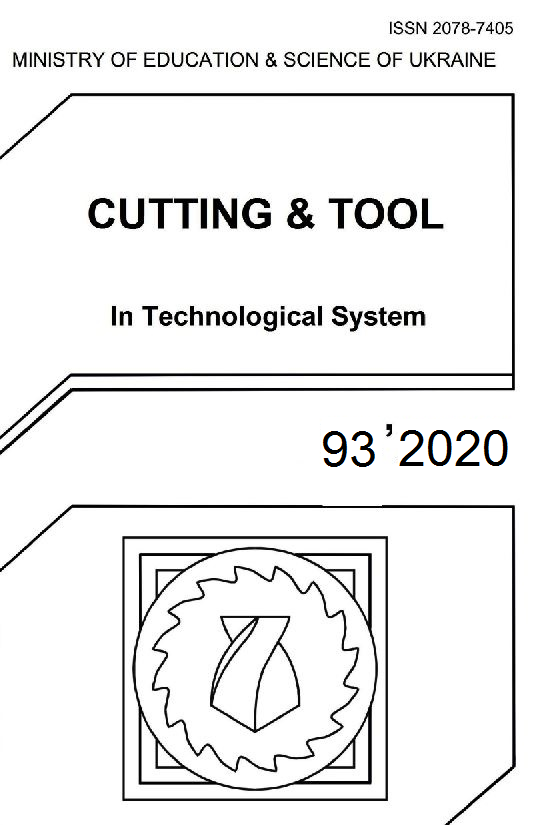FE INVESTIGATION OF SURFACE BURNISHING TECHNOLOGY ABSTRACT
DOI:
https://doi.org/10.20998/2078-7405.2020.93.01Keywords:
, lifetime-increasing surface hardening technologies, burnishing process, surface roughness, polycrystalline diamond, finite element (FEM) model.Abstract
This paper investigates the finite element analysis of cold forming diamond burnishing process on aluminium alloy, where the input parameters are force, feed rate and speed, as an output parameter the changing of surface roughness is analysed. This lifetime increasing process effectively reduces roughness, improves shape correctness, and increases the hardness of the sub-surface area. Machining simulation of the turned surface before burnishing is based on the real model, corresponding to the measured values, by using DEFORM-2D software in order to validate the improvement of surface quality with numerical values too.References
L. Balint, L. Gribovszki: A gépgyártástechnológia alapjai, Miskolci Eyetem, (1975) 418-442.
G. Bagyinszki, E. Bitay: Felületkezelés, Erdélyi Múzeum-Egyesület, Műszaki tudományos füzetek 5. (2009) 9-85.
A.A., El-Nasr: Thermomechanical fatigue behavior of burnished 7075-T6 aluminium alloy, Proceedings of the 15th Int. AMME Conference (2012) 40-50.
Z.D., Kadhim, M.A., Abdulrazzaq, W.S., Hussain: Mechanical properties of burnished steel AISI 1008, Al-Khwarizmi Engineering Journal, 14: 4 (2018) 133-142.
L., Gribovszki: Gépipari megmunkálások, Miskolc, Egyetemi Tankönyvkiadó (1977) 421.
A., Abodena: Optimization of surface roughness of brass by burnishing, The International Journal of Engineering and Information Technology, 5: 2 (2019) 90-96.
A., Bougharriou, K., Sai, W., Bouzid: Finite element modeling of burnishing process, Materials Technology: Advanced Performance, Materials 25:, (2010) 56-67.
A., Rodriguez, L. N., Lopez De Lacalle, A., Celaya, A., Lamikiz, J., Albizuru: Surface improvement of shafts by the deep ball-burnishing technique, Surface and Coatings Technology, 206:1, (2012) 2817-2824.
Y.C., Yen, P., Sartkulvanich, T., Altan: Finite element modeling of roller burnishing process, CIRP Annals-Manufacturing Technology, 54:1, (2005) 237-240.
F., Klocke, V., Backer, H., Wegner, M., Zimmermann: Finite element analysis of the roller burnishing process for fatigue resistance increase of engine components, Proceedings of the Institution of Mechanical Engineers, Part B: Journal of Engineering Manufacture 225:1, (2011) 2-11.
M., Sayahi, S., Sghaier, H., Belhadjsalah: Finite element analysis of ball burnishing process: comparisons between numerical results and experiments, The International Journal of Advanced Manufacturing Technology 67:5-8, (2013) 1665-1673.
J., Kundrák, C., Felhő: 3D Roughness Parameters of Surfaces Face Milled by is Special Tools, MANUFACTURING TECHNOLOGY, 16:3 (2016) 532-538.
C., Felho, A., Nagy, J., Kundrak: Effect of Shape of Cutting Edge on Face Milled Surface Topography, LECTURE NOTES IN MECHANICAL ENGINEERING, 46:10, (2020) 525-534.
J., Kundrak, C., Felho: Comparison of theoretical and real surface roughness in face milling with octagonal and circular inserts, KEY ENGINEERING MATERIALS 581, (2014) 360-365.
M., Posdzich, R., Stöckmann, F., Morczinek, M.,Putz: Investigation of a plain ball burnishing process on differently machined Aluminium EN AW 2007 surfaces, MATEC Web of Conferences 190:11005 (2018) 1-7.
DEFORM v12sp2 System Documentation July 2, 2020; Scientific Forming Technologies Corporation.
Downloads
Published
Issue
Section
License
Copyright Notice
Authors who publish with this Collection agree to the following terms:
1. Authors retain copyright and grant the Collection right of first publication with the work simultaneously licensed under a Creative Commons Attribution License that allows others to share the work with an acknowledgement of the work's authorship and initial publication in this Collection.
2. Authors are able to enter into separate, additional contractual arrangements for the non-exclusive distribution of the Collection's published version of the work (e.g., post it to an institutional repository or publish it in a book), with an acknowledgement of its initial publication in this Collection.
3. Authors are permitted and encouraged to post their work online (e.g., in institutional repositories or on their website) prior to and during the submission process, as it can lead to productive exchanges, as well as earlier and greater citation of published work.

